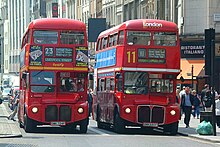AEC Routemaster
Compared to modern buses, the high floor design was inaccessible for the disabled, and made boarding with heavy luggage or pushchairs challenging.
In 2006, the Routemaster was voted one of Britain's top 10 design icons which included Concorde, Mini, Supermarine Spitfire, London tube map, World Wide Web and the K2 telephone box.
The Routemaster was designed by London Transport and constructed at Park Royal Vehicles, with the running units provided by its sister company AEC.
[10] As well as a novel, weight-saving integral design, it also introduced for the first time on a bus independent front suspension, power steering, a fully automatic gearbox and power-hydraulic braking.
[2] This surprised some early drivers, who found the chassis unexpectedly light and nimble compared with older designs, especially as depicted on film on tests at the Chiswick Works skid pan.
Production of mechanical components was undertaken chiefly at AEC's Southall site (though a significant number had Leyland engines) with body construction and final assembly at Park Royal Vehicles.
RMCs had modified suspension and interiors to allow a longer range and more comfortable running, an electrically operated door instead of an open platform, and a semi-automatic gearbox with higher gear ratios.
The British Electric Traction subsidiary Northern General Transport Company introduced the RMF in 1964/65, with an initial batch of 18, followed by another 32 and later joined by the prototype RMF1254.
[21][22] This order created considerable interest and raised eyebrows within the bus industry, as Northern had been one of the biggest investors in the new rear-engined Leyland Atlanteans.
Northern Routemasters were well liked by their crews: the high axle ratio meant a good turn of speed on long-distance routes such as Newcastle to Darlington, and power steering was well appreciated on busy urban services in Gateshead and Sunderland.
Painted in a variety of colours, they were used in regular service in Bedford, Blackpool,[35] Burnley,[36] Carlisle, Corby, Doncaster,[37] Dundee, Glasgow,[38] Hull,[39] Manchester,[40] Perth,[41] Rotherham.
Stagecoach used vintage Routemasters in its new corporate livery of all-over white with red, orange and blue stripes, to start one of its first operations, Magic Bus, in Glasgow in the late 1980s.
They used conductors to compete on speed in the town centre and, in the outskirts, took advantage of the rear platform to operate hail and ride sections of route.
The peak era of the Routemaster was in its first 25 years of operation, until September 1982, when the type started to be withdrawn and transferred to training fleets, due to service reductions.
Subsequent Routemasters, the last 500 of which were RMLs, began replacing the previous generation of buses, the AEC Regent RT and Leyland Titan RTL and RTW.
As the number of Routemasters declined, financial cutbacks and newer buses not suited to this practice were introduced, the overhaul routine was abandoned and Aldenham Works closed in November 1986.
[54] During this time, following the failure and premature withdrawal of heralded replacement vehicle classes such as the Daimler Fleetlines, the Routemasters that had not yet been disposed of saw their lives extended for use until privatisation.
[56] Opponents also pointed specifically to the lack of accessibility of the Routemaster in light of impending relevant legislation, which meant all new buses now entering service in London would be required to have a low-floor design.
[58] In March 2003, Peter Hendy, then managing director of Surface Transport for TfL noted that the implementation of a low floor, accessible bus fleet was a higher priority than keeping the historic Routemaster buses.
[59] Despite criticism from the media and the public,[60][61] remaining services were consequently replaced from August 2003 onwards by low-floor double decker or articulated buses, as existing bus contracts were renewed.
On 8 December 2005, 24 special buses, including preserved RMs and RMLs and their predecessors from the AEC Regent III RT bus family made guest appearances on route 159.
The route goes past iconic attractions like Big Ben and Westminster Bridge, and is solely operated by AEC Routemaster buses.
[72][73] Unlike previous heritage routes, a higher price is charged than the standard TfL bus fare, however the ticket is valid all day.
[70] Routemasters have also been exported, with some seeing further service in Australia, Canada (Victoria, British Columbia, Niagara Falls, Ontario and Toronto), China, Colombia, Croatia, the Falkland Islands, Malaysia, New Zealand, Sri Lanka and the United States.
The BBC states, "ubiquitous black cabs and red double-decker buses all have long and tangled stories that are deeply embedded in London’s traditions".
[81] In December 2014, the PepsiCo brand 7 Up worked with the inventor of yarn bombing, Magda Sayeg, to completely knit an original Routemaster bus.
On 3 September 2007, Conservative mayoral candidate Boris Johnson announced that he was contemplating introducing a modern-day version of the Routemaster (and scrapping articulated bus operation).
The results of the competition were published on 19 December 2008, with the winning and other good proposals being passed to bus manufacturers to draw up a final design.
In 1985, the rear stairs and the boarding platform were swapped left and right to make them suitable for left-hand drive traffic in mainland China.
[citation needed] RM1288 was withdrawn in 2015, sold to Great European Carnival (HKGEC) and then preserved at Kam Tin campsite in Forest Valleyland.










(Beatrix – EYY 776B)
Currently owned and being upgraded by the "London to Japan in a Routemaster Bus project" [ 24 ]




















